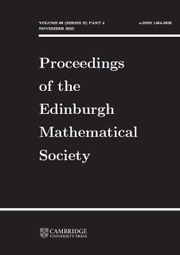Article contents
A Proof of Kirkman's Hypothesis
Published online by Cambridge University Press: 20 January 2009
Extract
The theorem which I propose to establish first attracted my attention while I was turning over the pages of a volume of Cayley's Collected Mathematical Papers (Cayley, 1). The enunciation of the theorem (with no attempt towards a proof) had been published earlier by Kirkman (3) in a lengthy paper on combinatorial analysis (one of the three-score papers of which Kirkman was the author); among the topics discussed in this paper was the enumeration of the total number of different ways D(r, k) in which a (convex) polygon of r sides can be dissected into k+l parts by drawing k non-intersecting diagonals (i.e., no two diagonals may cross each other except at a vertex or outside the polygon).
Information
- Type
- Research Article
- Information
- Proceedings of the Edinburgh Mathematical Society , Volume 13 , Issue 2 , December 1962 , pp. 131 - 138
- Copyright
- Copyright © Edinburgh Mathematical Society 1962
References
- 3
- Cited by

